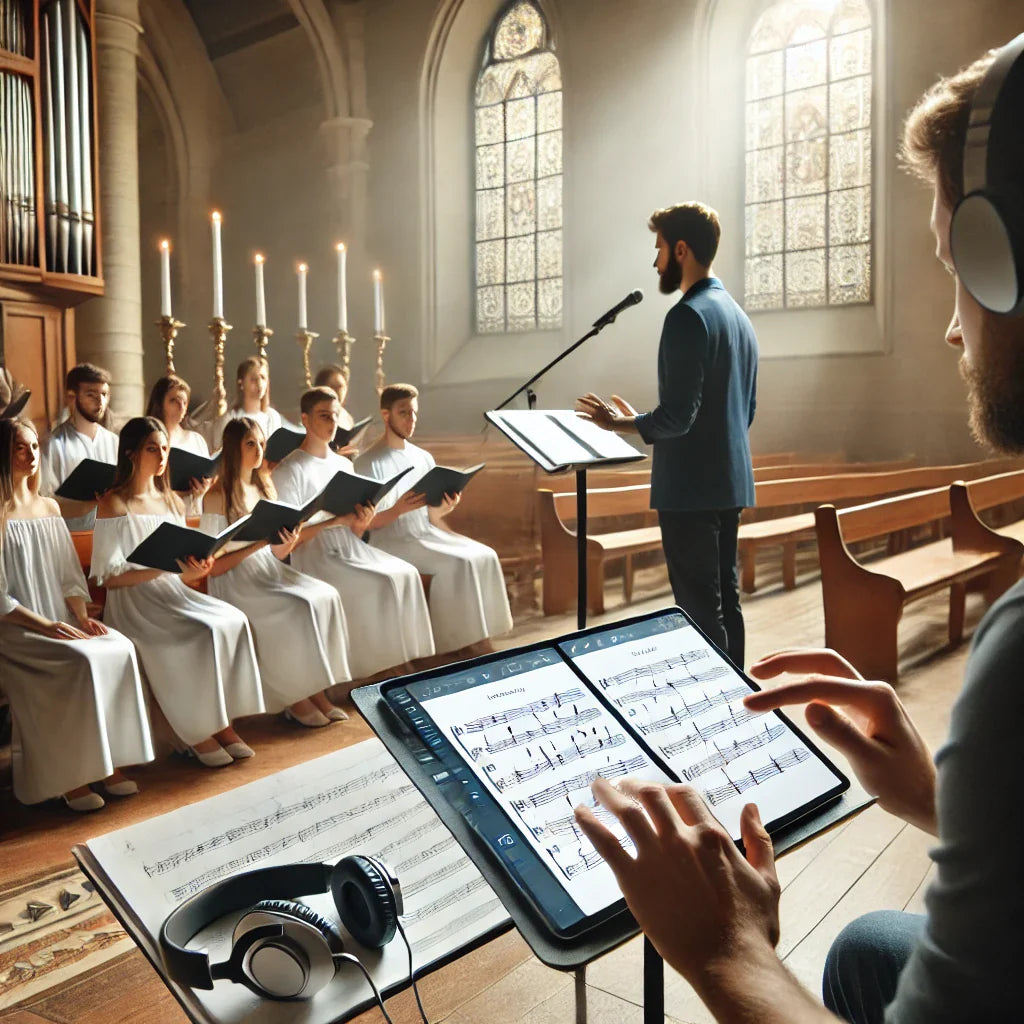
Using Technology to Learn Sacred Music
|
|
Time to read 4 min
|
|
Time to read 4 min
Sacred music has been an integral part of worship for centuries, enhancing liturgical celebrations and deepening spiritual experiences. With advancements in technology, learning and mastering sacred music has become more accessible than ever. Whether you are a choir director, a church musician, or an individual wanting to enhance your liturgical singing, digital tools can aid in music learning, practice, and collaboration.
This guide explores various technological resources—including apps, online tutorials, and digital collaboration tools—that can help individuals and church choirs learn, rehearse, and perfect sacred music. Additionally, we will highlight insights from choir directors who successfully integrate technology into their rehearsal processes.
Digital tools allow singers to practice anytime, anywhere.
Online sheet music and audio resources reduce dependence on physical copies.
Virtual training sessions help those with limited access to music teachers.
Apps with built-in metronomes and pitch analysis can help refine skills independently.
Slow-down and looping features in music apps help break down complex pieces.
Visual and interactive tools enhance sight-reading skills.
Apps with guided vocal warm-ups and exercises improve technique over time.
AI-driven vocal coaches offer real-time feedback on intonation and rhythm.
Virtual rehearsals enable remote choir members to stay engaged.
Shared cloud storage ensures easy access to music sheets and recordings.
Online discussion forums foster knowledge sharing between musicians worldwide.
Digital notation software allows for real-time collaborative composition.
MuseScore – Free sheet music and composition tool with playback features.
Learn to Sing – Provides vocal training exercises for pitch and tone control.
Sight Reading Factory – Helps improve sight-reading skills through interactive exercises.
Voice Training - Learn to Sing – Teaches vocal exercises and helps singers develop their range.
Vocal Pitch Monitor – Real-time pitch tracking for improving vocal accuracy.
Sing Harmonies – Helps singers practice harmony by providing different vocal parts.
Perfect Ear – Offers music theory and ear training exercises to develop pitch recognition.
Harmony Helper – Allows users to upload sheet music and practice their vocal parts.
CPDL (Choral Public Domain Library) – A vast collection of free sacred music scores.
IMSLP (International Music Score Library Project) – Houses thousands of classical and liturgical compositions.
YouTube Channels
Catholic Choirs: Instructional videos for Gregorian chant and polyphony.
MusicTheory.net: Free lessons on reading music and understanding notation.
Choir Masterclass: Advanced vocal techniques for choir singers.
Liturgical Music Academy: Tutorials on sacred music composition and performance.
Audacity – Free audio editing software to record and analyze vocal performances.
GarageBand – Apple-based digital audio workstation for creating and layering vocal harmonies.
SmartMusic – A tool that provides real-time feedback on pitch and rhythm accuracy.
Acapella App – Helps singers record multi-part harmonies for self-practice.
Soundtrap – A cloud-based recording studio for collaborative choir projects.
Using Zoom or Google Meet : Enables virtual rehearsals and discussion sessions.
Sectional Rehearsals via WhatsApp or Telegram : Sharing recordings for individual parts before full choir practice.
Using Click Tracks : Helps singers practice in time with the choir arrangement.
Recording Rehearsals for Feedback : Allows singers to analyze their performance post-rehearsal.
Conducting Virtual One-on-One Coaching : Helps refine individual vocal technique before group practice.
Google Drive & Dropbox : Stores sheet music, recordings, and practice tracks.
Notion & Evernote : Helps choir directors organize rehearsal notes and schedules.
ChoirPro : A specialized app that allows choirs to store digital sheet music and organize performance schedules.
Slack for Choirs : Provides a structured communication channel for organizing practice sessions and sharing insights.
Fr. Michael, a choir director from Mumbai : Uses MIDI files to help singers learn complex harmonies before live rehearsals.
Sister Anne, a choir leader in the U.S. : Implements an app-based warm-up routine that enhances vocal consistency.
John Doe, a European choir master : Uses virtual reality (VR) environments to simulate real-time church acoustics for training.
Maria Gonzalez, a choir trainer in South America : Uses AI-powered vocal analysis apps to monitor progress and suggest improvements.
Balance tech-based learning with traditional methods.
Encourage live practice to develop a natural sense of timing and vocal blend.
Avoid dependency on auto-tuning apps that might weaken vocal technique.
Use ear training exercises to maintain strong aural skills without visual aids.
Verify sheet music accuracy from trusted sources.
Cross-check interpretations with experienced choir directors.
Be cautious with self-learning from unofficial online videos.
Look for peer-reviewed digital sheet music collections to ensure authenticity.
Use "Do Not Disturb" mode on phones during practice.
Set clear expectations for tech use in rehearsals.
Avoid excessive reliance on recorded tracks over live vocal practice.
Maintain a balance between digital tools and live director-led instruction.
Apps with real-time feedback on pitch and pronunciation.
AI-assisted vocal training tools to customize exercises based on singer weaknesses.
Deep-learning algorithms that adapt practice sessions to individual progress.
Immersive practice sessions with simulated church acoustics.
Choir members rehearsing together in a virtual sacred space despite being geographically apart.
Virtual reality conducting lessons to train choir directors remotely.
More digital spaces for Catholic musicians to collaborate and share resources.
Global networking of liturgical musicians through online workshops and events.
Increased partnerships between church music directors and app developers.
Digital festivals celebrating sacred music compositions from diverse cultural backgrounds.
Technology has revolutionized the way sacred music is learned, practiced, and performed. From mobile apps to online collaboration tools, digital advancements offer unprecedented convenience and efficiency for choir members and individuals dedicated to liturgical music. By integrating these tools responsibly, church choirs and musicians can maintain the beauty and reverence of sacred music while adapting to modern learning methods.
With ongoing technological innovations, the possibilities for enhancing sacred music education will only continue to expand. Choir directors, singers, and church musicians who embrace digital tools while staying rooted in the sacred tradition can elevate the quality of liturgical music for the glory of God and the enrichment of faith communities worldwide.